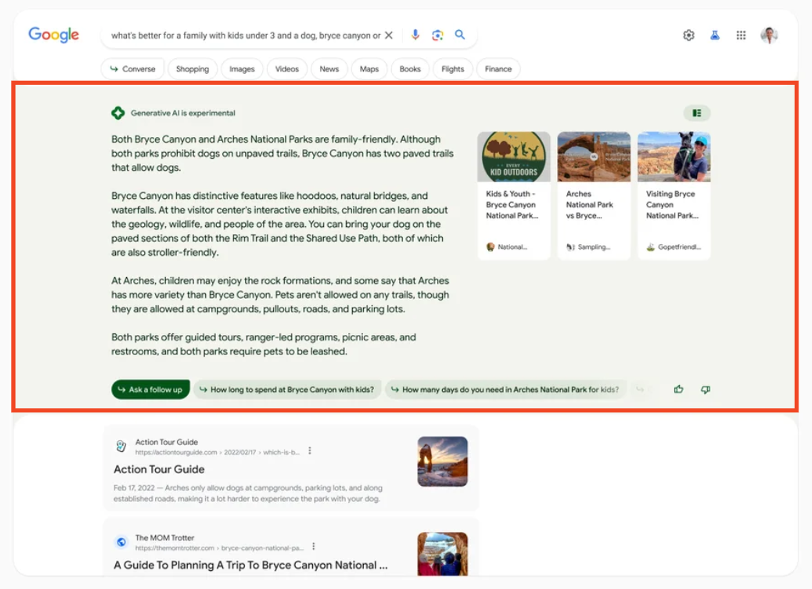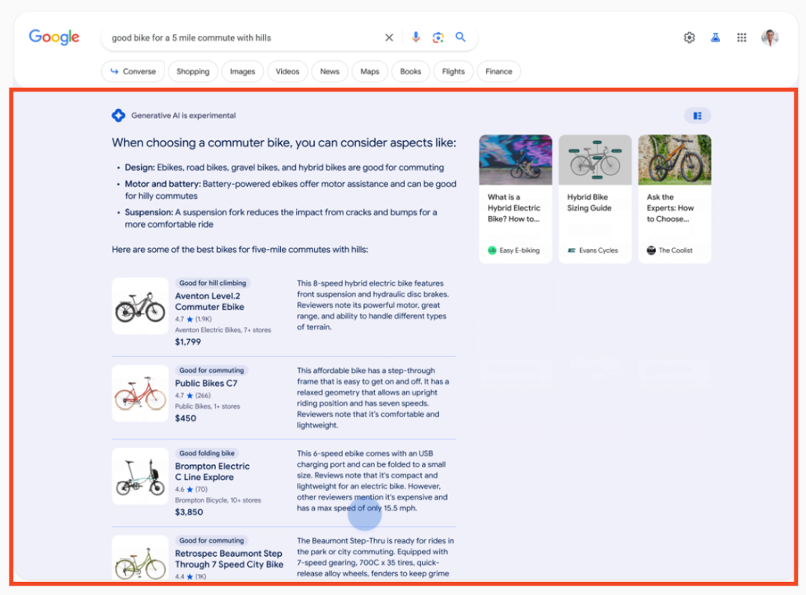Blog
Google AI Overviews: How the Evolution of Search is Changing Text Automation

Daniel Niedermayer
Google has recently introduced AI Overviews (former SGE or Search Generative Experience). This is a chatbot based on generative AI within the Google search. AI Overviews is integrated into the search page and is designed to satisfy specific information needs. While for example the AI assistant Google Bard is based on the large language model LaMDA (Language Model for Dialogue Applications), AI Overviews relies on other language models – including MUM (Multitask Unified Model) and PaLM2 (Pathway Language Model 2).

For now, Google AI Overviews is only available as a closed beta version in the USA. However, initial conclusions can already be drawn. Google is taking more control over user search behaviour with AI Overviews. At the same time, user intent becomes more important than ever. Therefore, specific product information is significantly upgraded. Accordingly, we deem targeted search engine optimisation crucial for businesses in order for their own products to be found. With Google AI Overviews, the user takes centre stage, with the aim being to persuade them with customised product information. However, the importance of established Google elements such as HowTo Rich Snippets and FAQ Rich Snippets has now virtually plummeted to zero.
Google AI Overviews Brings Generative AI into Search
With Google AI Overviews, generative AI is integrated into the search engine. To use it, the AI Overviews functionality is automatically displayed on the Google homepage and needs to be activated by the user. Instead of merely displaying 10 blue links on the first search results page, Google AI Overviews generates a text based on various sources that relates to the question entered. At the same time, Google AI Overviews offers a carousel with 3 boxes or links (AI-Snapshot) that serve as sources of the generated AI information and should initiate user research.
In our tests, these “AI Overviews Boxes” were not always executed after activation by the Google search. Therefore, it is quite possible that the display depends on individual user behaviour. With the AI-Snapshot, we noticed during testing that the top 3 in organic search are not always displayed. In this way, Google is taking a step into the future, where the boundary between organic and paid search results is blurred.

AI-based responses and boxes that refer to the information sources
In product searches, shops that have the sought-after product in stock are displayed in the AI-based responses. By clicking on one of the shops, the user is taken directly to the product detail page where the offer can be purchased.

Google AI Overviews directs the user straight to the relevant product page
How might Google AI Overviews change the search?
What does Google AI Overviews mean for digital commerce and B2B companies, but also for publishers and publishing houses that rely on organic traffic and retargeting? Below are our 5 theses, that are based on our initial AI Overviews tests:
1. Content discovery shifts towards Google
The launch of Google AI Overviews might result that users spend longer on Google and less time on the provider’s pages themselves, as they are already getting more information during their search. So, the discovery phase for user purchases should move somewhat forward to Google.
2. Less organic traffic from Google
In the future, historical top placements and strong conversion offers might disappear from the visible screens and SERPs – and generate noticeably less traffic due to the AI Overviews overlays. Fewer visits to a website in turn reduce the retargeting opportunities.
3. Product detail pages become central for SEO rankings
It’s quite possible that category pages and relevant sub-pages might lose importance due to Google AI Overviews. In contrast, detailed, SEO-optimised product detail pages should gain significantly in importance. To generate relevance, the quality of the content will likely become more important than ever. Alongside a website’s reputation, high-quality and varied text about products and topics should become crucial.
4. Google Shopping is being upgraded
In the AI-Snapshot, Google mixes organic and paid search placements, which should give Google Shopping another boost. The trick of SEO will be getting into the carousel of links within these boxes, to give users the opportunity to continue researching. According to our initial tests, it’s not always the organic top 3 that are displayed. Hence why the question arises, on what basis Google will rank these different sources?
5. User Generated Content and Product Reviews are particularly important
Google AI Overviews is likely to rely on User Generated Content and Product Reviews, as this is an indicator of the relevance of offers. So, product and brand communities should become increasingly important. Reviews help to identify and classify user intents – and play a major role in purchasing decisions.
What is the incentive to produce convincing content in the future?
Considering content discovery via Google AI Overviews, one wonders what the incentive for digital commerce, the publishing sector and beyond is to produce high-quality content when information is directly available on Google.
The way users will search should fundamentally change, and depend on the formulation of the content, with a much stronger emphasis on product detail pages. Here at Retresco we see greater potentials in FAQs and comparable explanatory formats. These types of text not only have the advantage of optimising information best for Google, but detailed product information also offers clear benefits to users – triggering conversions.
Given Google AI Overviews and its capabilities, it is more important than ever to produce high-quality, product-specific information. This revolves around creating targeted strategies to succeed in a dynamic market environment. Product-led SEO should become indispensable to be found and to sell. With this product-driven SEO approach, the user and their interests are the focus – that’s what content, SEO and marketing teams should focus on in the future.
Scaling text automation in light of Google AI Overviews
Given the latest developments around Google AI Overviews, the concept of Large Scale Content Automation (LSCA) is more relevant than ever. LSCA is the Retresco strategy for users to generate high-quality, varied web, product and SEO texts in large volumes automatically.
Large Scale Content Automation presents itself as a key solution for content creation at a time when Google is becoming the main source of information more than ever. This strategy allows for the production of legally impeccable, grammatically correct and substantial texts on a large scale. Individual adjustments regarding tonality and wording for different products, brands and channels can be made – while humans can intervene at any time.
The biggest advantages of Large Scale Content Automation are its efficiency, scalability and quality. It allows for text automation without much effort and can help improve visibility from organic search rankings significantly. At a time when category pages should lose importance and focus is directed towards product detail pages, LSCA can help improve the quality of content in all desired languages and ensure high relevance with Google. Large Scale Content Automation provides an optimum solution to automate content workflows and act successfully under the altered conditions.
In short: As soon as Google AI Overviews is rolled out internationally, the scalability and variation of product information should be crucial for successful SEO.
For questions about Google AI Overviews, Large Scale Content Automation and the possibilities for your SEO rankings, we are happy to assist. Get in touch – our experts will gladly contact you!